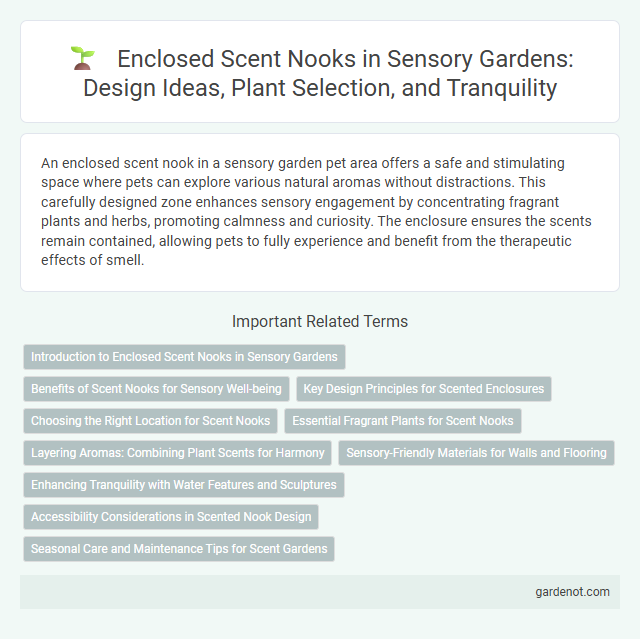An enclosed scent nook in a sensory garden pet area offers a safe and stimulating space where pets can explore various natural aromas without distractions. This carefully designed zone enhances sensory engagement by concentrating fragrant plants and herbs, promoting calmness and curiosity. The enclosure ensures the scents remain contained, allowing pets to fully experience and benefit from the therapeutic effects of smell.
Introduction to Enclosed Scent Nooks in Sensory Gardens
Enclosed scent nooks are specialized areas within sensory gardens designed to immerse visitors in a rich olfactory experience by surrounding them with fragrant plants such as lavender, rosemary, and jasmine. These nooks use natural barriers, like hedges or trellises, to concentrate scents and create a tranquil, intimate environment that encourages mindfulness and sensory exploration. Incorporating diverse aromatic herbs and flowers supports therapeutic benefits, enhances memory stimulation, and promotes relaxation.
Benefits of Scent Nooks for Sensory Well-being
Enclosed scent nooks in sensory gardens offer a concentrated and controlled environment that enhances olfactory stimulation, promoting relaxation and reducing stress. The carefully curated aromatic plants within these nooks support mental clarity, emotional balance, and sensory integration for individuals with sensory processing needs. This focused sensory experience fosters mindfulness and overall well-being by engaging the sense of smell in a therapeutic and immersive way.
Key Design Principles for Scented Enclosures
An enclosed scent nook in a sensory garden maximizes olfactory stimulation by using natural barriers like hedges or trellises to contain and concentrate fragrances. Selecting aromatic plants such as lavender, rosemary, and jasmine ensures a continuous seasonal bloom, creating layered scent experiences. Proper airflow control and tactile elements within the enclosure enhance sensory engagement while preventing scent dilution and cross-contamination.
Choosing the Right Location for Scent Nooks
Selecting an ideal spot for an enclosed scent nook requires assessing sunlight exposure and protection from harsh winds to preserve delicate aromatic plants. Positioning the nook near pathways or seating areas enhances visitor interaction and maximizes sensory engagement. Soil quality and drainage also influence plant health, making elevated or well-drained sites preferable for sustained fragrance release.
Essential Fragrant Plants for Scent Nooks
An enclosed scent nook in a sensory garden thrives on essential fragrant plants like lavender, rosemary, and jasmine, which release soothing aromas that enhance relaxation and sensory engagement. These plants not only provide rich, natural scents but also attract pollinators such as bees and butterflies, promoting biodiversity within the garden space. Incorporating herbs like mint and thyme adds layers of invigorating fragrance while offering tactile interaction for visitors.
Layering Aromas: Combining Plant Scents for Harmony
The enclosed scent nook in a sensory garden offers a carefully curated layering of aromas, blending fragrant plants like lavender, rosemary, and thyme to create a harmonious olfactory experience. Strategic placement ensures that each scent complements rather than overpowers, enhancing the therapeutic benefits for visitors. This multisensory approach stimulates memory and relaxation, making the garden a serene retreat for all senses.
Sensory-Friendly Materials for Walls and Flooring
Enclosed scent nooks in sensory gardens utilize sensory-friendly materials such as natural cork, soft wood paneling, and hypoallergenic, non-toxic paints for walls to reduce sensory overload and create a calming atmosphere. Flooring often incorporates textured rubber mats or natural fiber rugs like jute and sisal to provide tactile stimulation while ensuring safety and comfort. These materials are carefully selected to enhance olfactory experiences while maintaining an accessible, soothing environment for individuals with sensory processing sensitivities.
Enhancing Tranquility with Water Features and Sculptures
An enclosed scent nook in a sensory garden integrates water features and sculptures to amplify tranquility and stimulate sensory engagement. The gentle sound of flowing water promotes relaxation while strategic placement of aromatic plants around artistic sculptures creates a harmonious environment. This combination enriches the garden's sensory appeal, supporting mindfulness and stress relief.
Accessibility Considerations in Scented Nook Design
Enclosed scent nooks in sensory gardens prioritize accessibility by incorporating wide, level pathways and wheelchair-friendly surfaces to ensure ease of movement for all visitors. Plant selection emphasizes hypoallergenic and non-toxic scents to accommodate individuals with sensitivities or allergies. Tactile elements and clear signage with braille enhance multisensory engagement, supporting users with visual impairments.
Seasonal Care and Maintenance Tips for Scent Gardens
Seasonal care for an enclosed scent nook involves pruning fragrant plants like lavender and rosemary after their blooming period to promote healthy growth. Maintaining optimal soil moisture and mulching can enhance the release of essential oils during warmer months. Regularly inspecting for pests and removing wilted flowers ensures sustained aromatic intensity throughout each season.
Enclosed scent nook Infographic

 gardenot.com
gardenot.com